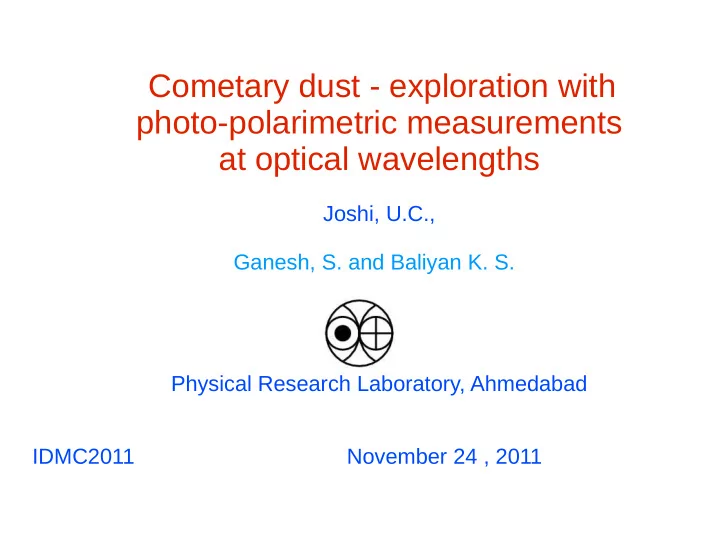

Cometary dust - exploration with photo-polarimetric measurements at optical wavelengths Joshi, U.C., Ganesh, S. and Baliyan K. S. Physical Research Laboratory, Ahmedabad IDMC2011 November 24 , 2011
Outline: ● Cometary dust ● Phase curve of comets at low phase angle: i) Enhancement of brightness near opposition and ii) Negative branch of polarization (NBP) Cases of the comets 17/P Holmes, C/2007 N3 (Lulin) etc are discussed. Joshi et al. MNRAS 2010 Joshi et al. MNRAS 2011
Scattering of Sun light by Comet dust makes them the most fascinating objects in the sky Comet McNaught Hale-Bopp
Why study dust in comets? Cometary dust contain pristine matter with signatures of formative stage of Solar System Spend most of their time away from Sun- less weathering
Dust characterization: - Polarization; - Thermal emission; - Dust particle trajectories; - in situ measurements;
CO AO AP CP Thermal emission model SEDs compared with the observed HIFOGS SEDs of comet C/2001 Q4 (NEAT) on (a) 2004 May 11.25 UT (chi^2 = 5.7) and (b) 2004 May 11.30 UT (chi^2 = 3.7). Model parameters for the grain size distribution are N = 3.7, ap = 0.3 micron, and D = 3 for solid grains. For model a (thick solid line), the number of peak grain size grains Np(x10^19), i.e., scaling factor, for five minerals are amorphous carbon (8.50; dashed line), amorphous pyroxene (7.00; thin solid line), amorphous olivine (3.55; long-dashed-- dotted line), crystalline olivine (24.2; dotted line), and crystalline orthopyroxene (0.77; dash-dotted line). For model b, all Np are multiplied by a factor of 0.53, except Np for amorphous carbon is multiplied by a factor of 1.06. For model a, the mass ratio to the total of submicron-radii grains is amorphous carbon : amorphous pyroxene : amorphous olivine : crystalline olivine : crystalline orthopyroxene = 0.15 : 0.17 : 0.08 : 0.58 : 0.02. This yields a silicate-to-amorphous carbon ratio of 5.7 and a silicate crystalline-to-amorphous ratio of 2.4. For comparison with C/1995 O1 (Hale-Bopp), from Harker et al. (2002, Fig. 7) or Harker et al. (2004, Table 4). Thermal emission
Results from Stardust mission
Cometary dust- Polarisation Studies Interaction of light with matter- Scattering Polarization of Solar radiation by Comet Coma depends upon • Incident wavelength • Phase angle • Refractive index of grains • Grain size distribution P = f( λ , n-ik, α , n(a)) Polarization measurements on a large phase angle range are crucial to model cometary grain characteristics
Conclusions: i) Polarizationin in NBP is found to be Wavelength dependent; maximum amplitude is more in red waveband compared to blue wavelength; The finding refutes the present belief that In NBP P% is not wavelength dependent. ii) No non-linear increase in brightness is detected; only a mild linear increase 0.041+-0.001 mag/deg, in phase angle range 1.7-11deg, is detected, which can be be explained with shadow hiding model.
Mt Abu Observatory Thanks for the Attention
Recommend
More recommend